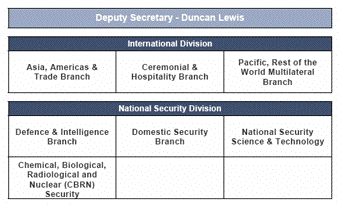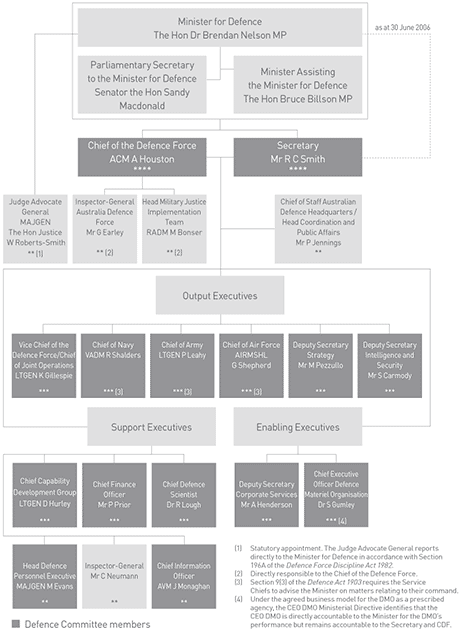Australian security policy organisation
Government sources
National Security Committee of Cabinet
At the political level, the Prime Minister chairs the NSC, the focal point of decision making on national security. It considers strategic developments and major issues of medium- to long-term relevance to Australia’s national security interests. In a security crisis it would meet as often as needed.
The committee consists of the:
- Prime Minister
- Deputy Prime Minister and the Minister for Transport and Regional Services
- Treasurer
- Minister for Defence
- Minister for Foreign Affairs
- Attorney-General.
Other ministers are seconded to the NSC when specific issues relevant to their portfolios are being addressed. Senior officials also attend the meetings: the secretaries of the departments of the Prime Minister and Cabinet, Defence and Foreign Affairs and Trade, the Chief of the Defence Force and the directors-general of the Australian Security Intelligence Organisation and the Office of National Assessments. Other secretaries and the Commissioner of the Australian Federal Police may be called upon to attend, when needed.
Secretaries Committee on National Security (SCNS)
“Supporting the NSC is the Secretaries Committee on National Security, comprising the heads of agencies engaged in national security issues, and chaired by the Secretary of the Department of the Prime Minister and Cabinet, Dr Peter Shergold AM.”
Department of Prime Minister and Cabinet
Prime Minister: John Howard
Secretary of the Department of Prime Minister and Cabinet: Peter Shergold
Deputy Secretary: Duncan Lewis – responsible for the National Security Division and the International Division and chairs the National Counter-Terrorism Committee.
International and National Security Divisions of the Department of the Prime Minister and Cabinet, May 2007

Department of Defence

Source: Department of Defence
Outcome Five: Strategic Policy, Outcome Performance, Annual Report 2005-06, Department of Defence
Strategic Policy Division activities report
Defence leaders: high profile senior personnel
Biographies of Department of Defence and Australian Defence Force senior figures
Minister of Defence:
Brendan NelsonSecretary of the Department of Defence
Nic WarnerDeputy Secretary Strategy (DEPSEC S)
Michael PezzulloOrganisation chart, Strategic Group, Department of Defence (accessed March 2007)
Chief of the Defence Force
Air Chief Marshal Angus HoustonVice Chief of the Defence Force
Lieutenant General Ken Gillespie
Intelligence
Shane Carmody
Deputy Secretary Intelligence and SecurityDirector Defence Intelligence Organisation
Director, Major General Maurie McNarnDefence Signals Directorate (DSD)
Director, Stephen Marchant (2004)Defence Imagery and Geospatial Organisation (DIGO)
Director Ian MackenzieOffice of National Assessments (ONA)
Director-General, Peter VargheseAustralian Secret Intelligence Organisation (ASIS)
Director-General, David IrvineAustralian Security and Intelligence Organisation (ASIO)
Director-General of Security, Paul O’Sullivan
Parliamentary sources
Chapter 3: National Security Strategy in Australia’s Maritime Strategy, the Joint Standing Committee on Foreign Affairs Defence and Trade, 21 June 2004. [PDF, 50.6 KB]
Analysis
National Security: Responding to the challenges, Duncan Lewis, Defence – The Official Magazine, April 2005.
“In response to the need to implement a fast-moving policy agenda focused on enhanced whole-of-government coordination, the National Security Division (NSD) was established within the Department of the Prime Minister and Cabinet (PM&C) in July 2003. NSD covers the full range of defence, intelligence, and international and domestic security issues. The division supports the Prime Minister in his role as chairman of the National Security Committee of Cabinet and works closely with other departments to ensure briefs and submissions coming forward for cabinet consideration provide ministers with the best possible advice upon which to make decisions.”
“The establishment in 1996 of a National Security Committee (NSC) of Cabinet and a Secretaries Committee on National Security (SCNS) laid the foundations for whole-of-government coordination. As cabinet minutes are binding on all Ministers as government policy and reflect collective decisions, timely and well coordinated consultation across government is important. The SCNS/NSC process has worked well, particularly at high levels, in ensuring consultation among those departments traditionally involved in national security.”
The New National Threat Assessment Centre, Parliamentary Library, Australia , Research Note No. 23, 1 December 2003
“Philip Ruddock, emphasised that the work of the NTAC is not new, but rather that the Centre represents a ‘refinement’ of existing arrangements. As such, the NTAC will centralise the existing threat assessment function already within ASIO, by housing representatives of those agencies with security responsibilities under the one roof. This should enable a faster, better co-ordinated sharing of information amongst local agencies and with overseas counterparts at any time of the day or night, and potentially enable threat assessments to be issued more quickly.”
Australia’s National Security Framework: A Look to the Future, Carl Oatley, Australian Defence Studies Centre Working Paper 61, October 2000.
Dated but useful review. Appendix A deals with the National Security Committee of Cabinet and Appendix B with the Secretaries’ Committee on National Security (SCNS), as of 1999.

